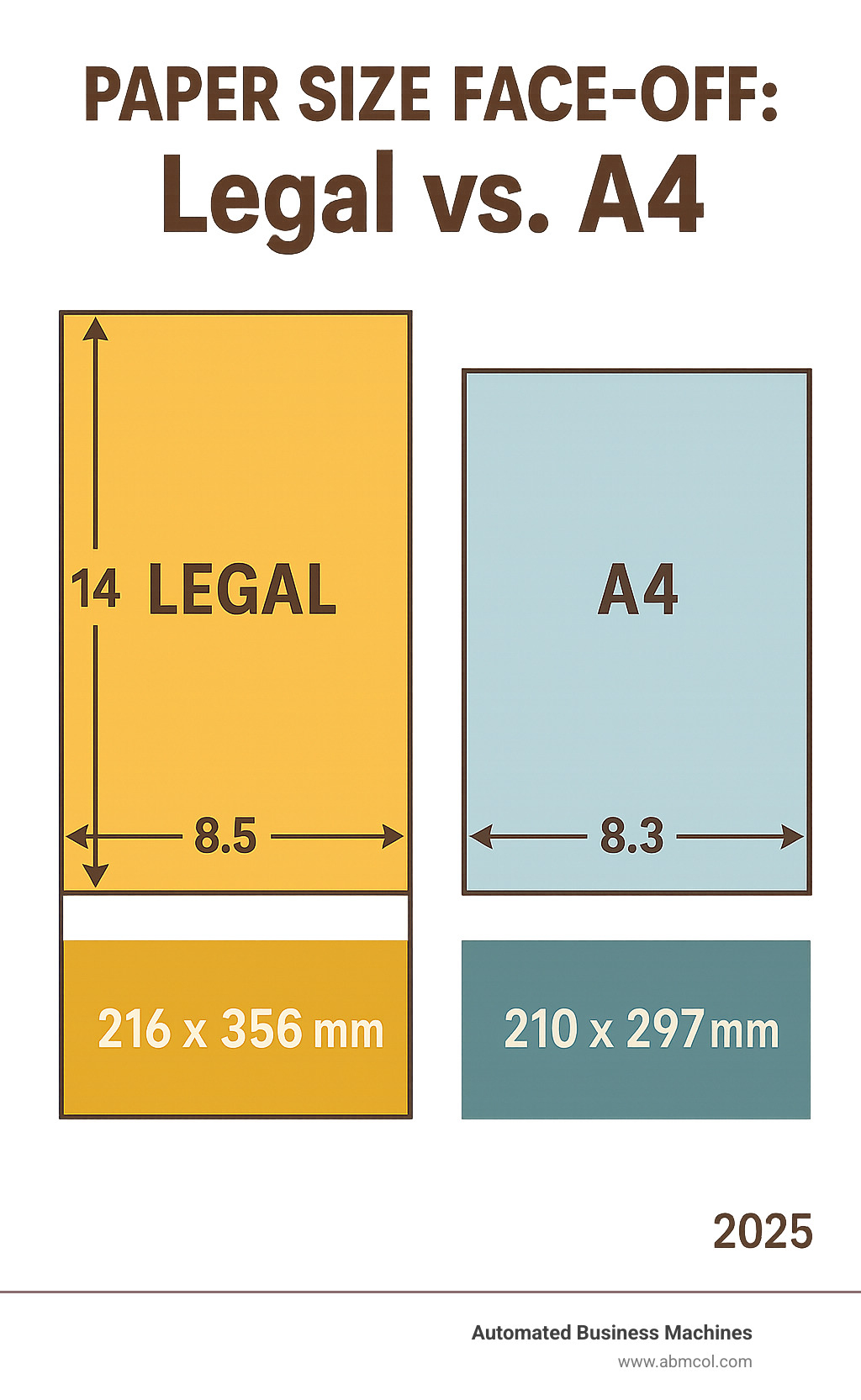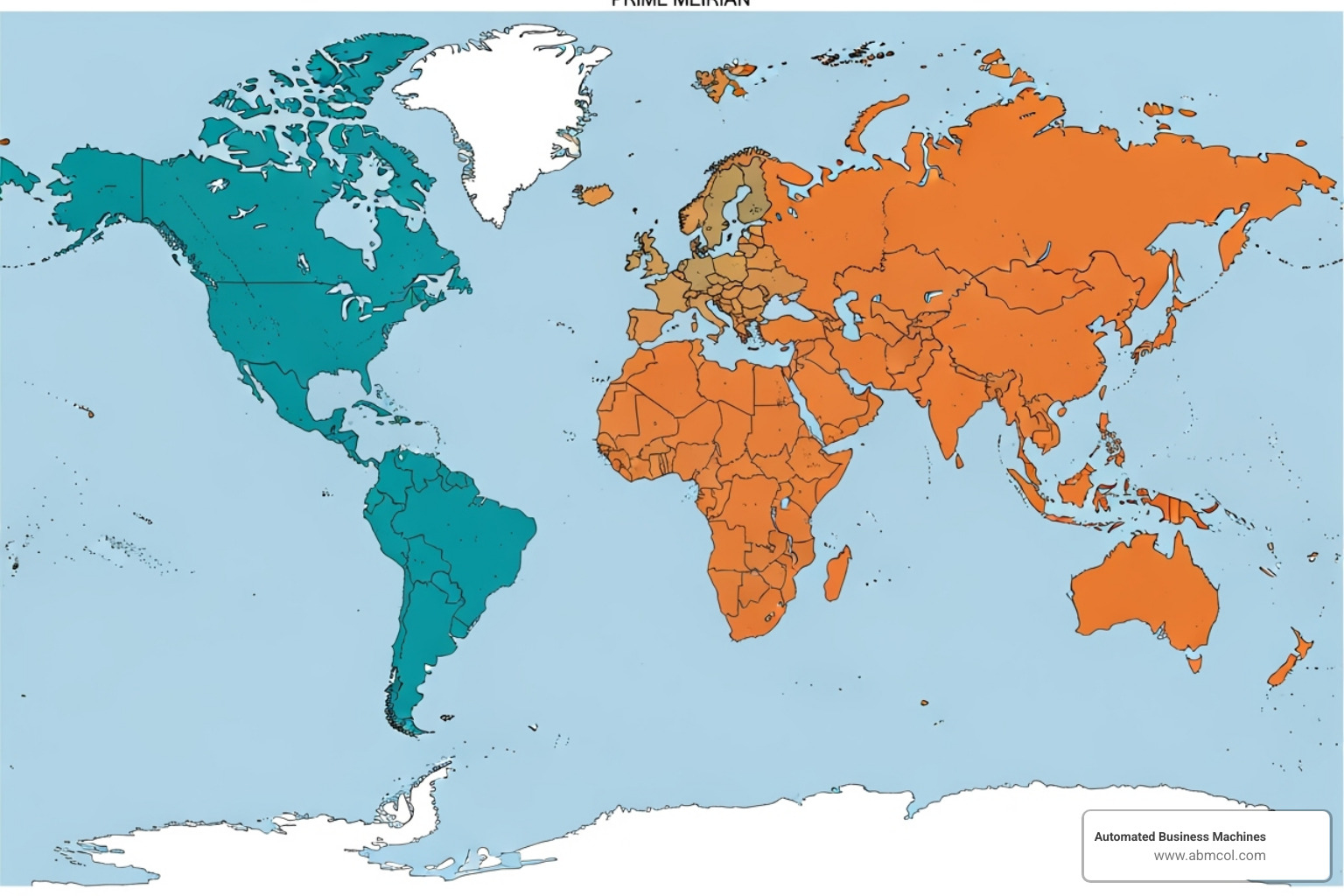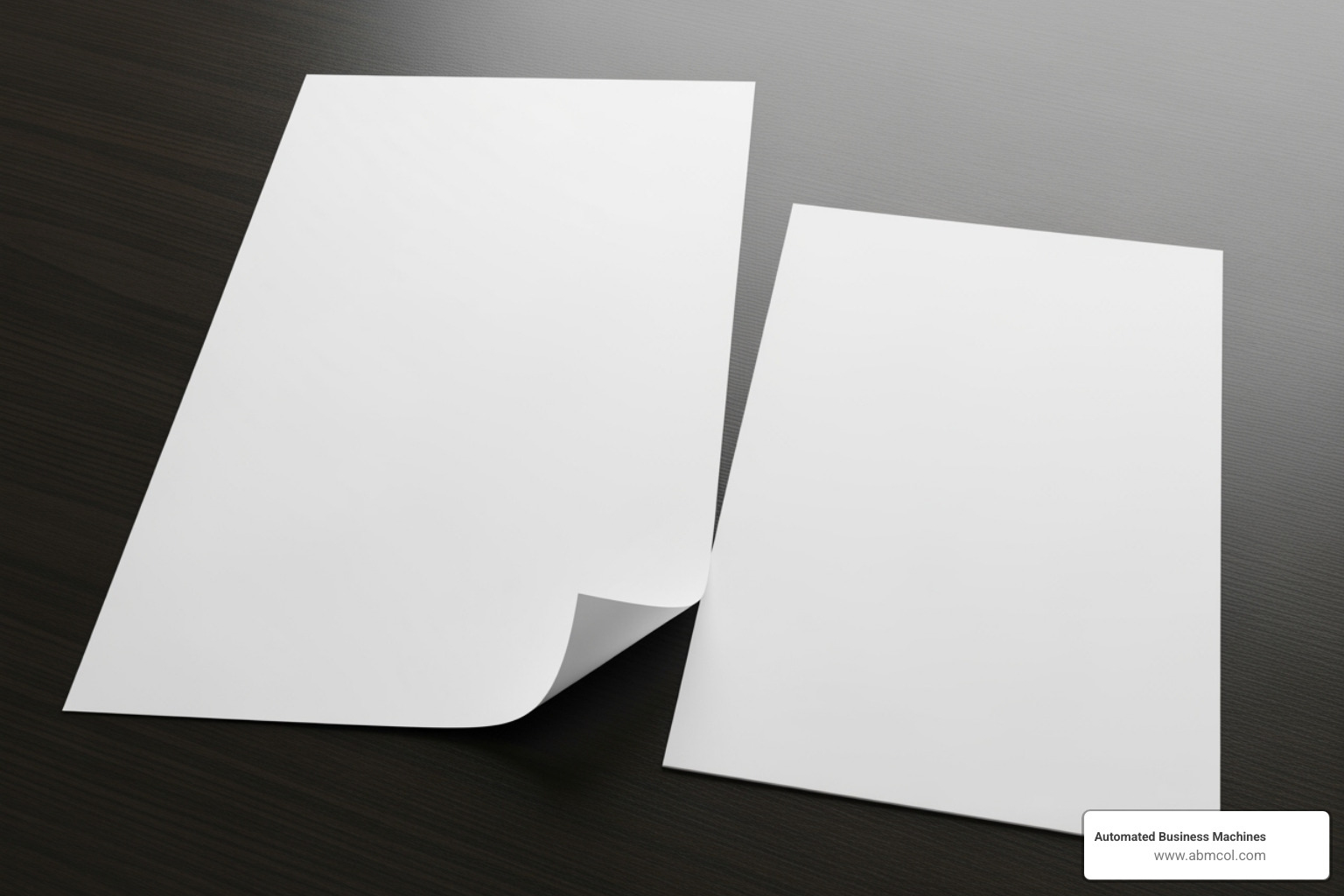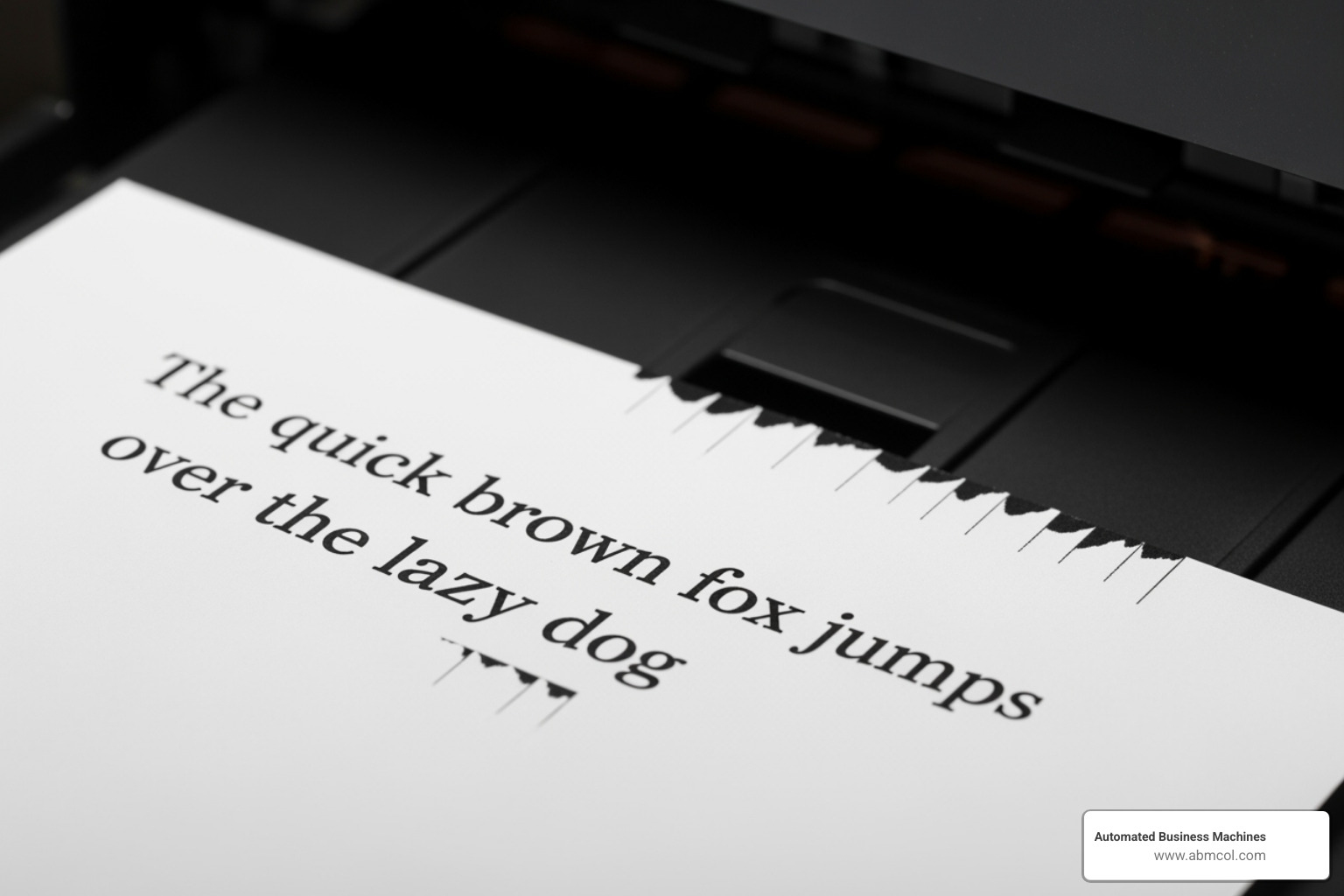
Paper size legal vs a4 represents one of the most common printing challenges faced by office managers worldwide. If you’ve ever printed a document only to find text cut off or awkward white space, you’ve experienced this format clash firsthand.
Quick Answer: Legal vs A4 Paper Comparison
- Legal Paper: 8.5 x 14 inches (216 x 356 mm) – Used primarily in North America
- A4 Paper: 8.3 x 11.7 inches (210 x 297 mm) – International standard used globally
- Key Difference: Legal paper is 6mm (0.2″) narrower but 59mm (2.3″) longer than A4
- Area: Legal paper has 0.015 square meters more area than A4
The confusion stems from two competing paper standards that divide the world. Most countries follow the ISO 216 standard (A4), while North America sticks to its traditional sizes like Legal and Letter. This split creates real headaches for businesses operating internationally or using equipment designed for different markets.
Legal paper was originally created for lawyers who needed extra length for handwritten notes and contracts. A4, on the other hand, emerged from a mathematical system where each size maintains the same aspect ratio when folded in half – a design that’s “obviously and dramatically superior,” according to paper size enthusiasts.
For office managers, this isn’t just trivia. Wrong paper sizes can mean cropped documents, wasted paper, and frustrated employees. Modern multifunction printers can handle both formats, but only if configured correctly.
When we talk about paper size legal vs a4, we’re diving into a fascinating world of international standards, historical quirks, and practical printing challenges. Our goal today is to clear up any confusion, so you can confidently choose the right paper for your needs and avoid those frustrating printing mishaps. Let’s get started!
At a Glance: The Core Differences in Paper Size Legal vs A4
When you’re dealing with paper size legal vs a4 confusion, the numbers tell the whole story. These two paper formats might seem similar at first glance, but their dimensions reveal some fascinating differences that can make or break your printing projects.
Let’s break down exactly what we’re working with here:
| Feature | A4 Paper | Legal Paper |
|---|---|---|
| Millimeters (mm) | 210 mm x 297 mm | 216 mm x 356 mm |
| Inches (in) | 8.3 in x 11.7 in | 8.5 in x 14.0 in |
| Width Comparison | 6mm (0.2″) narrower than Legal | 6mm (0.2″) wider than A4 |
| Length Difference | 59mm (2.3″) shorter than Legal | 59mm (2.3″) longer than A4 |
| Overall Area | 0.062 sq m (0.074 sq yd) | 0.077 sq m (0.092 sq yd) |
| Area Difference | 0.015 sq m (0.18 sq yd) smaller than Legal | 0.015 sq m (0.18 sq yd) bigger than A4 |
| Aspect Ratio | 1:1.4142 (approx. square root of 2) | 1:1.6471 |
| Standardization | ISO 216 Standard | North American/ANSI Standard |
The width comparison shows Legal paper is only slightly wider than A4 – just 6mm or about the thickness of a pencil. But here’s where things get interesting: the length difference is much more dramatic. Legal paper stretches 59mm (2.3 inches) longer than A4, which explains why documents formatted for one size often get cut off when printed on the other.
The overall area difference might surprise you. Legal paper gives you about 24% more writing space than A4. That extra real estate comes mainly from the added length, making Legal paper feel noticeably roomier for lengthy documents.
Here’s something cool about A4’s design: its aspect ratio of 1:1.4142 (the square root of two) means when you fold it in half, you get the exact same proportions. It’s mathematical elegance at work! Legal paper’s aspect ratio of 1:1.6471 doesn’t have this neat trick – it was designed for practical use rather than mathematical beauty.
The ISO 216 standard governs A4 paper worldwide, creating consistency across continents. Legal paper follows North American standards, which explains why it feels familiar if you’ve grown up with US office equipment but foreign if you’re used to international formats.
Want to dive deeper into these formats? Our Understanding A4 Paper Size guide covers everything about the international standard, while our comprehensive Legal Paper Size Guide explores the North American favorite in detail.
Understanding these core differences helps you avoid those frustrating moments when your perfectly formatted document suddenly doesn’t fit quite right. The devil really is in the details when it comes to paper size legal vs a4 compatibility!
Global Divide: Where Are Legal and A4 Paper Used?
The world of paper sizes has a clear geographical split that impacts international business and document sharing. When comparing paper size legal vs a4 usage, the divide between North America and the rest of the world becomes apparent.
Most of the planet follows the international ISO 216 standard, with A4 as the primary size. North America, however, uses its own Letter and Legal sizes. This difference reflects two approaches: a unified mathematical system versus sizes that evolved organically over time.
The Reign of A4: The International Standard (ISO 216)
A4 paper dominates the global stage. The ISO 216 standard is based on the metric system and a mathematical ratio (the square root of two). This design has a key benefit: when you fold any A-series paper in half along its longest side, you get the next smaller size with the exact same proportions. This A-series logic simplifies document scaling and reduces waste.
First developed in the early 20th century and standardized in 1975, the system is highly efficient. The largest size, A0, is exactly one square meter.
Global adoption is nearly universal outside North America. Europe, Asia, Africa, South America, and Australia all use A4. This widespread use makes international document exchange and filing consistent. For more on A4 paper weight, our A4 Paper GSM Guide has you covered.
The North American Exception: The Story of Legal Size
North America, including the United States, Canada, and parts of Mexico and the Philippines, uses traditional US paper sizes based on the imperial system. Sizes like Letter (8.5 x 11 inches) and Legal (8.5 x 14 inches) stem from historical precedent.
Legal paper’s extra length served a practical purpose. Early lawyers needed more space for handwritten notes and lengthy contracts. The longer format allowed them to include extensive text without constantly changing pages.
The name has roots in foolscap origin, an old British paper size favored by legal professionals. While the original foolscap was a different size, American Legal paper evolved to its current 8.5 x 14-inch dimensions. The ANSI/ASME Y14.1 standard formalized these sizes in 1995, long after they were in common use.
This history means that comparing paper size legal vs a4 is a look at tradition versus mathematical design. For help converting between metric and imperial, see our Legal Paper Dimensions In MM Essential Guide.
Form Follows Function: Common Uses for Legal and A4 Paper
The choice between Legal and A4 paper isn’t just about dimensions – it’s often dictated by the document’s purpose, industry standards, and even how it will be filed. Each size has evolved to serve specific applications, making them indispensable in their respective domains.
Understanding these common uses helps us appreciate why both sizes continue to exist and how they impact everyday workflows. Whether it’s for readability, compliance, or simply fitting into a standard filing cabinet, the right paper size is crucial for professional documents.
The reality is that paper size legal vs a4 isn’t just a technical discussion – it directly affects how your documents look, how they’re received, and whether they’ll work with your existing systems. We often help our clients choose the best paper types and sizes for their specific needs, ensuring their documents look professional and are easy to manage. For a comprehensive overview of your options, check out our Best Printer Paper Types Sizes Guide.
When to Use A4 Paper
A4 paper is the global workhorse. Its balanced dimensions and standardized nature make it ideal for a vast array of applications across almost all industries and regions outside of North America.
Business reports and presentations work beautifully on A4 because its standard size makes documents easy to bind, present, and distribute internationally. When you’re sending a quarterly report to partners in different countries, A4 ensures everyone can print and file it without issues.
Academic papers and textbooks rely heavily on A4 worldwide. Universities and educational institutions have built their entire printing and binding systems around this size. Whether it’s essays, research papers, or printed course materials, A4 is the educational standard.
For standard letters and everyday correspondence, A4 is the default choice. Its proportions provide enough space for professional communication without feeling oversized. International correspondence particularly benefits from A4 – if you’re communicating with a business partner in Europe, Asia, or Africa, an A4 document will fit their printers and filing systems seamlessly.
Brochures, manuals, and marketing materials work exceptionally well on A4. Its commonality ensures consistent printing and folding across different regions and equipment. Plus, the mathematical precision of the A4 system means scaling up or down maintains perfect proportions.
Essentially, if you’re operating in a global context, A4 is your reliable choice. It’s designed for efficiency and universal compatibility. For more detailed information on standard printer paper options, we recommend our Standard Printer Paper Size Information.
When to Use Legal Paper
Legal paper, while less common globally, holds a vital place in specific sectors, particularly here in North America. Its distinguishing feature – that extra length – is precisely why it’s chosen for documents that require more space or follow specific formatting requirements.
Legal documents and contracts are where Legal paper truly shines. As its name suggests, contracts, affidavits, court pleadings, and other formal legal instruments often use Legal paper to accommodate extensive text, multiple signatures, and official stamps without creating unnecessarily long documents with excessive pages.
Real estate transactions frequently rely on Legal paper for deeds, mortgages, and property agreements. These documents contain detailed legal descriptions, multiple party signatures, and official seals that benefit from the extra length. The additional space prevents cramped text and ensures all required information fits properly.
Accounting ledgers and financial documents take advantage of Legal paper’s extended length for more columns and rows. This makes it easier to track and analyze financial data without the document feeling cluttered or hard to read.
Wills, deeds, and government filings often require Legal paper by tradition or regulation. Many government forms are specifically designed for Legal paper dimensions, and important documents like wills benefit from the formal appearance and ample space for detailed instructions.
The professional appearance of Legal paper also lends gravity to important documents. There’s something about that extra length that signals “this is an official document” – which matters when you’re dealing with contracts worth thousands of dollars or legal agreements that will be referenced for years.
For more details on Legal paper’s dimensions and specific applications, our Legal Size Paper 8.5×13 In CM Dimensions Uses 2025 guide provides comprehensive insights.
The Printer’s Predicament: Solving Cross-Format Printing Challenges
Printing a document designed for one paper size on a different one often leads to formatting disasters like cut-off text and improper margins. This common issue when dealing with paper size legal vs a4 mismatches can cause wasted paper and toner.
The problem is a simple mismatch between the document’s design and the paper in the printer. This can lead to wasted paper, frustrated employees, and missed deadlines. Modern multifunction printers can handle these challenges, but they require the correct settings. Understanding a few key tricks can prevent these headaches. For more on getting the best results, see our guide on the Best Laser Printer Paper Types And Weights.
Printing A4 on Legal Paper: Solving the paper size legal vs a4 mismatch
Printing an A4 document on Legal paper (or vice versa) requires adjustments because the dimensions are different. Without them, you’ll get awkward scaling and unprofessional-looking blank spaces.
- “Fit to Page” or “Scale to fit paper size”: This is your quickest fix. Most printer drivers and PDF viewers have this feature, which automatically scales the content to fit the new paper size.
- Manual Magnification: For more precise control, you can manually adjust the scaling percentage. The exact number for paper size legal vs a4 depends on whether you prioritize width or height, so a test print may be necessary.
- Printer Driver Settings: Before printing, go into your printer’s properties. In the “Paper” or “Page Setup” section, specify the original document size (A4) and the actual paper size (Legal). This tells the printer exactly how to handle the conversion.
Getting it right might take a test print, but you can save the settings for future use. For more on size conversions, our article on how to Print Legal Size Document On Letter Paper offers related insights.
With smart planning, you can handle paper size legal vs a4 challenges easily.
- Design with Generous Margins: When creating documents for international use, use generous margins. This “universal layout” ensures the content looks good even when scaled.
- Accept Digital Workflows: Keep documents digital as long as possible. Share PDFs and collaborate online, printing only when necessary. This allows the recipient to adjust local settings.
- Use PDF Format: PDFs lock in fonts and layouts, ensuring consistency. They also offer robust scaling options for easy size adjustments.
- Configure Printer Trays: Properly configuring your printer trays prevents most issues. Set up different trays for different paper sizes (e.g., Tray 1 for Letter, Tray 2 for Legal) and label them clearly.
- Educate Your Team: A quick training session on paper sizes and printer settings can save hours of frustration. A key tip: always return printer settings to default after a special print job.
- Use Secure Printing: Our advanced systems can hold print jobs until user authentication, preventing waste from incorrect settings and enhancing security.
At Automated Business Machines, we help businesses across Georgia optimize these configurations. These practices create a seamless workflow, no matter the paper standard. For more on North American sizes, see our comparison of Legal Size Paper Vs Letter Key Differences.
Frequently Asked Questions about Legal and A4 Paper
Over our years of helping businesses across Georgia optimize their printing workflows, we’ve noticed the same questions pop up again and again. The confusion around paper size legal vs a4 is real, and honestly, completely understandable! Let’s clear up the most common mysteries once and for all.
Is Legal paper the same as A4?
Absolutely not! This misconception causes more printing headaches than you’d believe. We see it all the time in our service calls – someone assumes they’re the same size and ends up with documents that look like they went through a paper shredder.
The dimension difference is significant. Legal paper measures 8.5 x 14 inches (216 x 356 mm), while A4 comes in at 8.3 x 11.7 inches (210 x 297 mm). That means A4 is actually narrower by 6mm and shorter by a whopping 59mm. Try printing an A4 document on Legal paper without adjusting settings, and you’ll end up with awkward white space that screams “amateur hour.”
The regional difference tells the whole story. Legal paper is North America’s thing – we use it here in the US, Canada, and parts of Mexico. Meanwhile, A4 is the international standard that literally everywhere else has acceptd. If you’re doing business with someone in Europe, Asia, or pretty much anywhere outside North America, they’re using A4.
Then there’s the standardization difference. A4 belongs to the mathematically neat ISO 216 system, where everything scales perfectly. Legal paper? It’s based on historical needs rather than fancy math. Both have their place, but they’re definitely not twins.
Why is Legal paper longer than other standard sizes?
Here’s where history gets interesting! The extra length of Legal paper – that 14-inch dimension that makes it stand out – comes from the practical needs of lawyers back when everything was handwritten or pecked out on typewriters.
Picture this: lawyers’ notes sprawling across pages, handwritten contracts that needed room for every clause and sub-clause, and the simple need for extra writing space when you couldn’t just hit “insert page break.” Legal professionals needed paper that could handle verbose legal language without forcing them to flip pages constantly.
The foolscap paper history is even more colorful. The term comes from an old British paper size that featured a watermark of a jester’s cap – talk about adding some humor to serious documents! While foolscap isn’t common anymore, Legal paper inherited that tradition of providing generous space for important documents.
Those extra 2.3 inches of length weren’t arbitrary – they were born from necessity. Even though we live in a digital world now, established filing systems and the formal nature of legal documents keep Legal paper firmly in place for contracts, deeds, and court filings.
Can my office printer handle both Legal and A4 paper?
The good news? Most modern printers can absolutely handle both sizes! We’ve installed countless multifunction devices across Georgia, from Atlanta to Savannah, and virtually all business-grade equipment supports multiple paper sizes.
However – and this is a big however – your printer needs to be told what you’re doing. Paper tray settings are crucial. You’ll need to physically adjust those little guides in your paper tray to accommodate different sizes. Legal paper needs the full 14-inch length, so make sure your tray extends completely.
Driver configuration is where things get technical, but it’s not rocket science. Your printer driver needs to know what paper is loaded where. We spend a lot of time helping our clients set up their systems so Tray 1 might hold Letter paper, Tray 2 has Legal, and the bypass tray can handle A4 for those occasional international documents.
Many newer multifunction devices feature automatic size detection, which sounds fancy but really just means the printer can sense what paper you’ve loaded. The catch? Those tray guides still need to be positioned correctly, or the automatic detection gets confused.
Check specifications before assuming anything. While most business printers handle both formats, it’s always worth confirming in your printer’s manual or calling us for a quick verification. Trust us – it’s better to check beforehand than to find limitations when you’re rushing to print important documents for a Monday morning meeting!
Conclusion: Choosing the Right Paper for Your Needs
After exploring paper size legal vs a4, you’re now equipped with the knowledge to make smart decisions for your office. The choice between these two formats isn’t just about measurements – it’s about understanding your workflow, your audience, and your business needs.
Think of it this way: Legal paper (8.5 x 14 inches) is like that reliable pickup truck – built for specific heavy-duty jobs like contracts and legal documents. A4 paper (8.3 x 11.7 inches), on the other hand, is your versatile sedan that gets you everywhere smoothly, especially when dealing with international partners.
Regional awareness is your first step to success. If you’re sending documents to London, Tokyo, or Sydney, A4 is your best friend. But if you’re drafting contracts in Atlanta or filing government forms in Columbus, Legal paper often fits the bill perfectly.
Application matters more than you might think. You could print a simple memo on Legal paper, but why waste the extra length? Similarly, trying to cram a detailed contract onto A4 might leave you with cramped text and frustrated readers.
Workflow optimization is where the magic happens. Modern multifunction printers are incredibly smart – they can handle both formats beautifully when configured correctly. The secret is setting up your paper trays properly and training your team on the basics. We’ve seen too many offices struggle with simple scaling issues that could be solved in minutes.
Here’s something we’ve learned from helping businesses across Georgia: the companies that thrive are the ones that accept flexibility. They use PDFs for digital sharing, keep both paper sizes stocked, and aren’t afraid to adjust printer settings when needed. It’s not rocket science, but it does require a bit of planning.
At Automated Business Machines, we’ve helped countless businesses streamline their printing processes. Whether you’re in Marietta dealing with international clients or in Newnan managing local legal work, we understand that every office has unique needs. Our customized solutions and local support make sure your printing workflow runs smoothly, regardless of which paper size you choose.
The bottom line? Don’t let paper sizes intimidate you. With the right knowledge and properly configured equipment, managing paper size legal vs a4 becomes second nature. Your documents will look professional, your team will be more productive, and you’ll wonder why you ever worried about it in the first place.
For a complete guide to legal paper dimensions and how they fit into your office workflow, explore our Legal Paper Size & Paper Dimensions pillar page.




